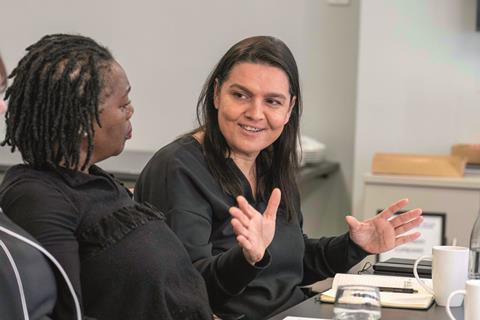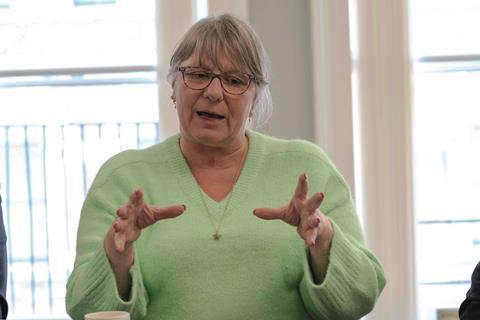Professional indemnity insurance roundtable: Soft sell
[ad_1]
At the table
Back row (l-r) Marc Rowson Lockton; Sheona Wood DWF; Paul Bennett Bennett Briegal; Eduardo Reyes Law Society Gazette; Stephen Ward Council for Licensed Conveyancers; Anna Newport Newport Land & Law
Seated, front row (l-r) Terry Seager Hera Indemnity; Tom Bedford Clyde & Co; Linda Lee Law Society PII committee, Weightmans; Donna Goodsell Goodsells Family Law; Zarina Lawley Miller Insurance

A prolonged ‘hard’ market for professional indemnity insurance broke any sense of a ‘cycle’ that had previously existed. But competition has increased for solicitors’ custom, and more capacity has been tempted in. Measured by price and capacity, the current market remains ‘soft’ by historical standards.
Benign conditions
‘We used to talk about the cyclical market,’ says Terry Seager, director of broker Hera Indemnity, such that people ‘anticipated’ a change in conditions ‘coming every five years or so. All of a sudden, there’s this hard market that lasts and lasts and lasts.’
In that context, a softer market ‘seems like a bigger deal’, he adds.
Marc Rowson, partner at broker Lockton, says: ‘We are certainly in a far more positive position than we were, say, 18, 24, 26 months ago.’
‘The criteria that these insurers have are wider, because they’ve realised, actually, they’ve all got the business budgets now, and to get more clients on their books, they’re going to have to widen their appetite’
Zarina Lawley, Miller Insurance
What is driving this? ‘Part of it is capacity, most certainly, but not just new capacity,’ Rowson explains, adding that ‘established providers [are] actually changing their positions’. There is not, he notes, a sense of a big new threat in the form of a new class of claims against solicitors.
In the harder market there was no ‘pressure’ for brokers and insurers ‘to grow their portfolio’, observes Zarina Lawley, head of solicitors’ PI at broker Miller Insurance. ‘As a result, they were not flexible… [But now] there’s more capacity. That’s creating the competition. Also, the criteria that these insurers have are wider, because they’ve realised, actually, they’ve all got the business budgets now, and to get more clients on their books, they’re going to have to widen their appetite. [So] rates are coming down,’ she says.
‘Some of my insured clients, particularly some of the larger firms, are becoming more discerning about where they get their insurance’
Tom Bedford, Clyde & Co

A softer market does not ‘filter down’ automatically to all, however, as sole practitioner Donna Goodsell of London firm Goodsells Family Law relates: ‘On the ground, my experience and that of other colleagues in family law, which I don’t think is high-risk, is that the premiums are eye-wateringly high.’
‘Family has, historically, been a low-risk area of work,’ Lawley responds, but the practice has developed some features noticed by insurers. ‘As you’re getting into more complicated family structures and divorces, it is getting a bit more risky,’ she reflects.
Seager is ‘surprised, and a little bit disappointed’ by Goodsell’s experience of high prices in family – absent any singular incident such as ‘an awkward probate case’ that would increase a firm’s risk. The consensus is that, as well as focusing on presentation of risk profile, this is a good time to ‘shop around’.
‘Over the last eighteen months, the conversations I’m having with my clients are that insurance isn’t the horror show that it has been. People are quite relaxed about their renewal’
Paul Bennett, Bennett Briegal
Tom Bedford, partner at Clyde & Co specialising in professional indemnity, observes a shift in the ‘power balance’ between law firms and insurers. ‘Some of my insured clients, particularly some of the larger firms, are becoming more discerning about where they get their insurance,’ he reports. ‘They want value from insurers, they want that support in terms of risk management compliance. Where they’re not getting that, they’re moving. So it’s not always about the cheapest premium, it’s about what kind of service they get.’
Paul Bennett, partner at Bennett Briegal, concurs: ‘I act for firms of all different sizes, from top-ten US firms down to the proverbial “sole practitioner in Skegness”. And suddenly, over the last eighteen months, the conversations I’m having with my clients are that insurance isn’t the horror show that it has been. People are quite relaxed about their renewal.’

Renewal questions
‘If it were my money, at the moment I’d probably go for an 18-month policy’
Terry Seager, Hera Indemnity
After the 1 October single renewal date was abolished in 2013, firms were free to begin choosing cover for longer periods and at different times. Linda Lee, a former Law Society president and now chair of its PII committee, has noticed a recent trend with regard to length.
‘My sense is that a lot of firms are not going to [sign up to an] 18-month policy, because their perception is that there are going to be more price drops down the line,’ she says. ‘I’d be interested to know if there is going to be a further drop, or if it would be better to go for an 18-month policy now.’
‘That’s a really tricky one,’ Seager replies. ‘If it were my money, at the moment I’d probably go for an 18-month policy.’ He reasons that the emergence of a softer market is relatively recent, and there are broader economic variables that are hard to forecast.

Lee also questions whether firms are wise to increase their insurance ‘excess’ in a bid to lower premiums, noting that, anecdotally, many firms seem to find that a higher excess does not actually lead to much of a reduction. Seager remarks that this will ‘depend very much on the size of the firm’ and whether the insurer has already gone ‘as low as they can go’ regardless of what level the excess is set at.
Lawley agrees, adding: ‘It’s really about how much risk appetite the law firm has… If you really believe that you’re absolutely not going to have a claim, then of course, take more risk [by raising your excess].’
Conveyancing trends
Conveyancing practices regulated by the Solicitors Regulation Authority (SRA) generally face the highest premiums, because of both their claims records and perceived risks. Anna Newport, solicitor and director at Newport Land & Law in Wakefield, reflects that this risk profile is in part caused by the low market value accorded to a complex area of law. Matters may be poorly resourced despite huge pressure to complete transactions, a combination that can lead to errors.
‘Conveyancing always gets a kicking, and there are lots of reasons why we’re higher risk or considerably higher risk,’ Newport reflects. ‘One of those reasons is that people are very emotionally involved with their homes. It’s the biggest spend they’re probably ever going to make and they’re impatient. Equally, conveyancing is considered to be transactional form-filling [which] people don’t need to apply their brains to.’
In reality, land law is highly complex and ‘needs craftspeople to deal with it’, she insists.

SRA-regulated firms find themselves paying more for insurance than those regulated by the Council for Licensed Conveyancers (CLC). Lawley explains: ‘Interestingly, when we look at the claims on the SRA firms versus the CLC firms, there is a difference. Because the CLC firms are only doing conveyancing, all their focus and all their expertise is just conveyancing, and there’s no dabbling – because you can’t. And it’s the dabbling that law firms fall down on; they go outside their expertise because they just want to get cash in. That’s when it starts to fall apart.’
Stephen Ward, director of strategy and external relations at the CLC, agrees that this has been the ‘real difference’ between SRA- and CLC-regulated firms in the eyes of insurers. He says: ‘Our firms will have the same challenges about presenting their work properly and effectively, and really showing how they shine and why they should be trusted in their proposals. But I think insurers come with a slightly different attitude towards CLC firms, because of their specialisation.’
The CLC revamped its participating insurers agreement with effect from 2023. While there is still a single renewal date, insurers are expected to make ‘timely’ offers to law firms. Ward says this has worked well and the CLC is ‘really happy’ with how the market is operating.
He adds: ‘Another manifestation of the turn in the market is that we saw one insurer depart last year but be replaced by another insurer with rather more appetite. So, that was an actual positive. I suppose you would characterise the departure as the last gasp [of] the hard market. The brokers that worked to our scheme responded very well to the firms that potentially found themselves without an insurer, or at least having to go to a new insurer for the first time. I think that encouraged them to shop around.’
Excess layers
Beyond compulsory primary cover of £2m or £3m, the market for ‘excess layers’ has also softened. But firms should take great care here, Rowson notes: ‘One caveat I would always give with excess layers is around coverage and the difference in the wordings of [policies]. There are vast differences that I don’t believe are always communicated to law firms. I think that’s a really important point as, hopefully, the excess layer market continues to soften.’
Some firms tend to buy too much coverage, observes Bennett: ‘I see firms act with an abundance of caution, buying millions of coverage, which their claims history just doesn’t justify. I’m thinking of a couple of small, City boutiques that I act for. They have, for ten or twelve years, bought a really significant excess layer. But if you look at their claims history and the type of work they’re doing, you see something completely disconnected. I think it comes down to that communication point. Can insurers improve communication around this type of coverage?’
Bedford interjects that there is also a lack of understanding of coverage for investigations against solicitors. He says: ‘A lot of firms or individuals I act for, in an SRA investigation or in proceedings, assume that they have insurance cover that kicks in. There is a real lack of education. It comes as a real shock to people.
‘Some firms do buy an extension to their policy, or have a separate D&O [directors and officers] policy, but quite a lot are exposed on this. Individual solicitors who are not partners, who are not necessarily senior people, but are the subject of an investigation and there’s no linked claim – they’re left without any insurance. They are remortgaging their house or using their life savings to pay people like us and there is something wrong about that. We need to do a lot more to educate.’
Risk: ‘Are you dealing with Paul Mccartney or Mr Jones?’
What tips can the experts offer when it comes to firms presenting themselves as a good risk? Marc Rowson, partner at Lockton; Terry Seager, director of Hera Indemnity; Zarina Lawley, head of solicitors’ PI at Miller Insurance; and Sheona Wood, partner at DWF all point to the need to ensure that the firm’s individuality shines through in the information they provide to insurers.
Rowson says: ‘The proposal [form is] very good at asking “what?”, but I think more could be done around “who?”. So, what’s the typical nature of your client? For instance, if you are a family law practice, are you dealing with Paul McCartney’s divorce, or are you dealing with Mrs and Mr Jones’ divorce? Going into more detail as to whom you act for – your typical profile of client – is really important.’
Seager has noticed proposal forms asking more and more of the same questions, to the point where there might even be an argument for a common form. ‘The only way to distinguish yourself is to get personal. We encourage our clients to give us a decent covering letter that explains a few basics about the firm, [although] you’re always going to be focusing on risk management and quality management. It’s all about, “we’re different because of this, we take this stuff seriously”; and that’s not going to come across from a proposal form. You have to do that another way.’
Lawley agrees that what is needed goes ‘beyond the proposal form’. She elaborates: ‘The proposal form is not enough. You’ve got to give that extra context around it and really, really hone down to why you’re different, why will your firm not have a claim, and also face up to what those risks are. If you are doing a higher-risk area of work, face up to it and say, “we know it’s high risk, but guess what? These are the steps we’ve taken to make sure we don’t have a claim”.’

Wood adds: ‘Underwriters are now looking at multiple aspects of a firm: culture, who your clients are, what your values are, what your workplace is like… [Solicitors need to] put that forward. Explain what your firm is like as a place to work and its profile, and if you possibly can, even meet the insurers. Then they’ll get a real sense of who you are and how your firm is run.’
The CLC’s Stephen Ward stresses that it is ‘very reassuring’ for insurers to be able to see ‘not only that [the policies] are there, but that they are being policed and monitored, and that this is effective… Firms often don’t put any thought into putting their best foot forward and selling their procedures and how they monitor [them].’
For Anna Newport of Newport Land & Law, being able to convey your risk ‘in a much more measured way’ is essential. She says firms need to get into a position where they can say “we’ve looked at this, we’ve been educated on that. We’ve had file reviews… we’ve had [an] audit, and we’ve looked at our actual risk before we’ve needed to, as part of our own overall management as a firm”.’

Paul Bennett, partner at Bennett Briegal, advises firms to highlight the training they have undertaken: ‘Firms spend thousands on training, and I rarely see them mentioning it to insurers… you can have the best policies, procedures, systems in the world, but are you training the team on them, and is that training effective? Does it bring those policies to life? If you get that across, you are effectively saying, “we supervise properly, we do it properly. We’re managing risk”,’ he says.
Donna Goodsell, sole practitioner at Goodsells Family Law in London, points out the need for firms that specialise in one area, such as family, to be given a chance to highlight to insurers that they do not ‘dabble’ in high-risk areas such as conveyancing.
Tom Bedford, partner at Clyde & Co, notes that ‘the firms that are received best by insurers are those that have a dedicated risk team embedded within the firm that is listened to by the firm’s leaders; and managing risk becomes part of the culture and not just something that has to be done.’
Linda Lee, chair of the Law Society’s PII committee and a consultant at Weightmans, has a note of reassurance for those firms that have been unfortunate enough to have had a claim on their PII policies. She says: ‘Make sure that you address how you’re going to deal with that so it doesn’t happen again. Make sure it’s believable and something that you can actually embed, and show how you’ve embedded it. Because that can make all the difference in terms of getting reasonably priced insurance. It’s not the end of the world if you deal with it properly.’
Areas of claim
What trends do the experts identify in terms of matters giving rise to indemnity claims?
Sheona Wood, a partner at DWF who specialises in defending professional negligence claims, observes: ‘The headline claims are getting much bigger: wills, probate, capacity issues, Court of Protection cases, they are increasing. And then trusts, trust corporations, tax schemes, all those kinds of areas. There are also a lot of property claims, both residential and commercial properties, leases, enfranchisement, extensions and fractional investments.’
Bedford notes that in a recent market survey carried out by his firm Clyde & Co, insurers and brokers reported that while claims volumes were fairly subdued, the severity of claims had increased. ‘There’s definitely claims inflation,’ he remarks. ‘I think there are a few reasons for that. We’re seeing more claims from third parties, be it administrators due to the general economic climate – with 2023 seeing the highest rate of administrations since 1993 – and because of the long-tail nature of claims, we will see that trickle through.
‘I’ve also seen claims by litigation funders, which give rise to difficult issues in terms of existence of duty, scope of duty and then privilege issues when it comes to defending the claim.’ He adds: ‘There are more litigants in person as well, probably due to the lack of legal funding and resources becoming more available online, and things like AI actually helping those individuals bring their claims. That can lead to greater claims costs, because although you’re not necessarily paying the other side’s costs, your costs of defending are normally greater when you deal with a litigant in person. We’re seeing a lot more allegations, in negligence claims, of breaches of regulatory duties.’
Wood is also seeing more claims brought by liquidators and administrators, and adds: ‘What’s worrying about that is there’s a very developed ATE [after-the-event] market specifically for insolvency practitioners, which means they have no skin in the game. I also agree that there are more litigants in person, and it’s incredibly expensive to deal with those claims.’
Bedford notes that many in the market expected a surge of claims following the Covid pandemic, when solicitors had to pivot to a new way of working. ‘People like me were sitting around saying, “we’re going to have a load of claims after this, there’s going to be lots of problems”. And actually we haven’t seen that. Although claims can be long-tail, we would know by now if that’s what we were going to see.’
Bennett highlights how well lawyers adapted during the pandemic, and how this led to ‘good habits’ by firms in relation to the supervision of more junior lawyers, and making sure that the right conversations take place between staff. He adds: ‘I think what we’re seeing in the market conditions is, yes, a bit more capacity; yes, a bit of a softer market; but we’re also seeing that there hasn’t been that flurry of claims because supervision is just that little bit better.’
Bedford adds that whereas previous conversations with insurers may have focused on the risks posed by law firms, now the story is more positive. ‘Solicitors [deserve] a bit of good PR, because actually, they do make good risks. We’re not all bad.’
- This roundtable was kindly sponsored by PII brokers Lockton, Miller Insurance and Hera Indemnity
Photographs by Noah Da Costa
Eduardo Reyes is features editor at the Law Society Gazette; Rachel Rothwell is a freelance journalist
[ad_2]
Source link




